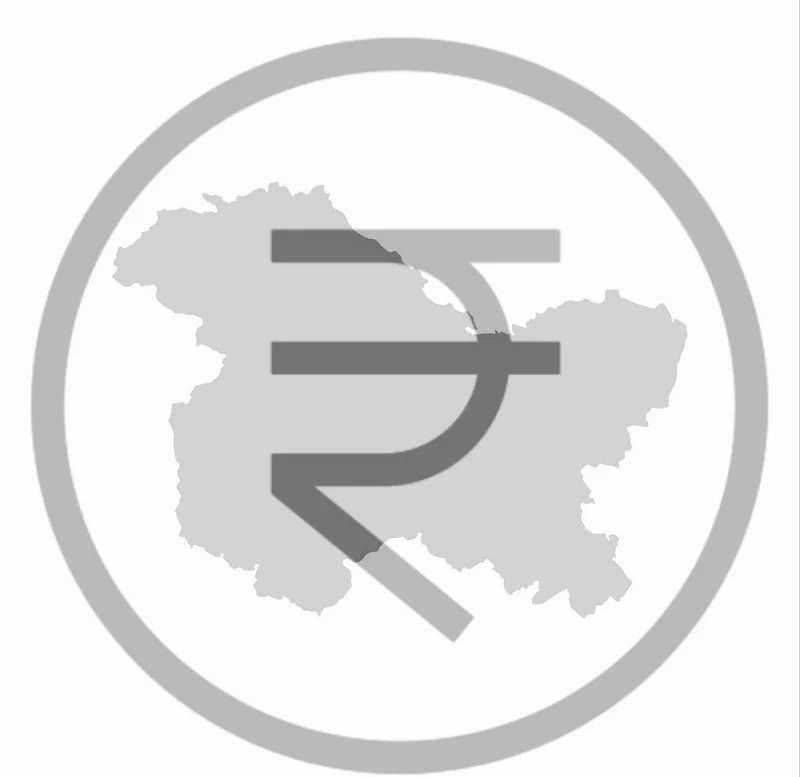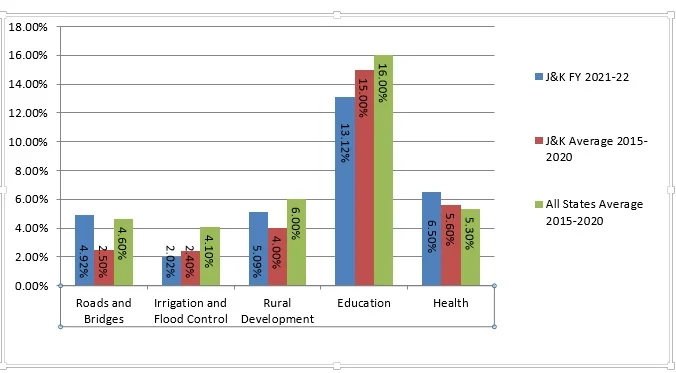
FAR from the democratic ruins of the ghostly legislative assembly of the erstwhile state, Jammu and Kashmir’s annual fiscal policy was again presented in the citadels of New Delhi for the second consecutive year. Terming it an era of hope and positivity for the Union Territory of Jammu and Kashmir, the union finance minister spoke at length, as to how the new bureaucratic run arrangement has checked corruption, strengthened Grass-root democracy, transformed governance & accelerated development.
This is how budgets, central as well as at the state levels, have always been presented. Laden in the velvet of rhetoric and glossed with a selectively chosen set of numbers, the idea is to project an image of achievement, progress and growth while carefully working around the not-so-pleasing statistics in order to maintain the public confidence in the policies. Given the complexity of this financially technical document, it is important that we demystify this enigma so that the debate penetrates into day to day conversation of commoners. Since the authority to decide on taxes stands surrendered by the states to the GST council in 2017, state/UT budgets are mostly limited to deciding on the spending and borrowing program. These two data points will therefore remain the focus of this column.
Fiscal Hindsight:
Since the difference between announcements and achievements is only getting wider, therefore, before embarking on the projected Rs. 1.08 Lakh crore budget announced for financial year 2021-22, let us take a brief look at the achievements of the current financial year.
Compared to the projected budget estimate of RS.1.01 lakh crore for FY 2020-21, the revised estimate shows that the actual spending has been limited to Rs. 92,341 only i.e less by Rs. 9087 crore which is around 9% less. This contraction has been driven by a drastic drop in revenue receipts which fell short by Rs. 15,197 crore i.e. around 16.68% less than what was projected for the current financial year. Break-up shows that GST collections have fallen short by 23.42%, sales tax by 19.33% and excise duty & tax on goods by 29.05%. To further aggravate the choke on receipts, the entitled resources from the center which included GST compensation, fell short by a whopping Rs. 14521 Crore i.e. around 20.80% of the projected number.
The revenue expenditure on the other hand has almost remained the same. This means that the axe of this unprecedented shortfall in receipts had to be compensated by either compromising on the allocations towards capital expenditure or through raising more debt or both. This is exactly what has happened. The revised budget for FY 2020-21 witnessed around 31% drop in capital expenditure i.e. a curtailment of spending by Rs. 8803 crore. Since this curtailment falls woefully short of the requirement to match the shrinking receipts, the Govt. had to go for a borrowing spree. Compared to a projected borrowing program of Rs. 7917 crore for FY 2020-21, the revised estimates show that the Govt. had to borrow an additional Rs. 6413 crore i.e. a spike of 81% on the projected estimates, in order to balance the falling revenues. Pertinent to mention that this is besides the debt of Rs. 11,025 crore raised during the current financial year for clearing power purchase liabilities under the Atma Nirbhar Abhiyan.
This disruption of fiscal math on account of sluggish receipts has resulted in a sharp rise of around 53.41% on the projected fiscal deficit which as per revised estimates stands at Rs.15710 crore as against the project value of Rs. 10240 crore. Therefore, the fiscal picture which is emerging for FY 2020-21 is a lot uglier than the one conceived by GoJK while drafting the budget last year.
Expenditure projections:
Although the structural impediment of having to support a disproportionately bloated Govt. sector does eat away the major portion of J&K’s resources, however, focusing on the allocation towards creation of public assets, no matter how small, is extremely essential in improving the standard of living and holistic economic well-being. As already discussed, the projected allocation towards capital expenditure in the current financial year had to be drastically downsized due to squeeze in receipts. The projections for 2021-22, however, have been made almost at a level similar to budgeted estimates of the current financial year. Against a projection of Rs. 38,764 crore for current financial year, the projections for next financial year have been pinned at Rs. 39,817 crore, i.e. an increase of only 2.71%. When compared to the revised spending of only Rs. 29,855 crore for FY 2020-21, the projections for 2021-22 are far bigger at 33.36%. That’s how the low base effect works. The growth in allocation is almost entirely driven by the Infrastructure sector with allocations towards sub-component public health engineering (PHE) projected at an exponential growth of 410.26%.

Comparison of key sector spending with other state averages:
For economic backbone i.e. Roads and bridges, the combined revenue and capital allocations of Rs. 5354.93 crore for FY 2021-22 is around 4.92% of the total expenditure. To put things into perspective, states across India have spent around 4.60 % at an average of their budget size on roads and bridges during the last 5 years. J&K’s allocation during the same period was around 2.5% only.
For Irrigation and flood control, the allocations at 2197.54 crore (revenue plus capital) is only 2.02% of the total spending program. States across India have spent around 4.1% at an average of their budget size on this essential sector in the last 5 years. J&K’s average for the last 5 years for this segment has been around 2.4%. Given the geographical and climatic risks that J&K is exposed to, these miserly and continuously dwindling allocations deserve to be revisited for sure.

In case of Rural Development which includes expenditure on implementation of various rural development schemes, such as the National Rural Employment Guarantee Scheme, and the Swachh Bharat Mission J&K’s total projected expenditure for FY 2021-22 is around Rs. 5531.31 crore. This is around 5.09 % of the total budget. During the 2015-20 period, states across India on an average have spent 6% of their budget on rural development.
Education sector has been allocated a combined revenue plus capital allocation of Rs. 14,254.75 Crore which is 13.12 % of the total expenditure side. Pertinent to mention that J&K’s average allocation towards education in the last 5 years have been around 15% of the spending. During the same period, states across India on an average have spent 16% of their budget on the education sector. The prevailing educational infrastructural gaps in the region ironically deserved a much liberal spending in capital allocation, however, the same is not reflecting in number. A similar dismal allocation of only Rs. 105.91 crore towards science and technology too has been a disappointment.
Health sector has been the prime focus across the globe in wake of the pandemic. This sector witnessed a surge in expenditure in the current financial year with revised expenditure higher than what was projected. A somewhat similar projection has been made for the coming financial year as well. J&K in the last five years has been spending around 5.6 % of its total expenditure on health and family welfare. The average for all states combined has been only 5.3%. For FY 2021-22, the combined allocation under revenue and capital heads for health sector arrives at an impressive 6.5% of the total expenditure.
The two main resource drags in J&K’s budget comprise of the energy sector and the expenditure on police. Compared to an average spending of only 4.1% by all states during the 2015-20 period, J&K spent around 9.3% of its average budget on police for the same period. The projections for FY 2021-22 are no exception. In case of expenditure on energy which includes subsidy to consumers, allocation for power projects, and assistance to discoms under UDAY scheme, J&K has spent the highest percentage of its budget i.e. 15.7% during the last five years on energy compared to average of only 6.2% spent by other states during the same period.
Debt:
Borrowing is an essential public finance tool used to create revenue generating assets and public infrastructure. As long as it’s not used as an escape route to fulfill revenue gaps and not availed beyond the state’s capacity to repay, it can be a healthy catalyst for revving up growth. J&K’s pile of debt is one of the highest in the country when compared to the UT’s economic size. A debt to GSDP ratio of around 48% is quite unhealthy. This was made even worse by a whopping 81% escalation in borrowing in the current financial year. At an average more than 42% of the own revenue receipts in GoJK’s annual budget were consumed in debt servicing in the last 5 years. All India average for all the states combined was only 23%.
The total annual interest payments for FY 2021-22 have been projected at Rs.7692 crore under revenue expenditure and an amount of Rs. 4226 has been allocated for loan repayments under capital expenditure. Therefore, a total of Rs. 11,918 crore is leaking annually towards interest servicing and debt repayment. To put things into perspective, this amount is around 73% of the UT’s own tax base. This is besides the debt of Rs. 11,025 crore raised during the current financial year for clearing power purchase liabilities under the Atma Nirbhar Abhiyan. This is how serving debt is leading to shrinking elbow room for the already starved developmental expenditure.
Given the very small role played by J&K’s private sector in the economy, Govt’s annual budgetary allocations are systemically essential drivers which alone have the ability to chug the rusted wheels of the economy smoothly. Being the biggest spender with big pockets and a deep borrowing capacity, GoJK’s effectiveness or lack of it in policy formulation & implementation can make or break the already limping economy of J&K. The infrastructural push is expected to create a multiplier effect and trickle down to the lower strata of the economic layers. A sustained commitment towards the health sector too is a decision in the right direction. Piling debt is a serious concern which can shrink the UT’s room for developmental expenditure in future. Leaking revenue on costly energy purchases, sustaining a huge security apparatus and serving interest deserve to be addressed consciously in order to create a more fiscal space for public good. However, skepticism arises when one looks at the optimistic projections of yesteryears and then compares it with the unfolded reality. Hope this time it’s different and the projections do not deviate much from the expectations and deliver holistically on good governance, inclusive public welfare and sustained economic well-being.
- Views expressed in the article are the author’s own and do not necessarily represent the editorial stance of Kashmir Observer
Follow this link to join our WhatsApp group: Join Now
Be Part of Quality Journalism |
Quality journalism takes a lot of time, money and hard work to produce and despite all the hardships we still do it. Our reporters and editors are working overtime in Kashmir and beyond to cover what you care about, break big stories, and expose injustices that can change lives. Today more people are reading Kashmir Observer than ever, but only a handful are paying while advertising revenues are falling fast. |
| ACT NOW |
| MONTHLY | Rs 100 | |
| YEARLY | Rs 1000 | |
| LIFETIME | Rs 10000 | |











